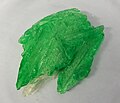Ferric
Ferric is a term often used in chemistry to refer to compounds that contain the element iron in a +3 oxidation state. It is derived from the Latin word ferrum for iron.
Chemical Properties[edit]
Ferric ions are often found in nature as iron(III) oxides or hydroxides. These compounds are commonly known as rust, which is a form of corrosion that occurs with iron and its alloys. Ferric ions can also form complex ions with other elements, such as the ferricyanide ion, [Fe(CN)6]3−.
Biological Importance[edit]
In biological systems, ferric ions are essential for the function of many enzymes and proteins. For example, the heme group in hemoglobin, which is responsible for oxygen transport in red blood cells, contains a ferric ion. Iron is also an important nutrient for humans and other animals, and it is often found in foods in the ferric state.
Industrial Uses[edit]
Ferric compounds are used in a variety of industrial applications. For example, ferric chloride is used in water treatment to remove impurities. Ferric oxide is used as a pigment in paints and ceramics, and it is also used in the manufacture of steel.
Health Effects[edit]
Excessive exposure to ferric compounds can have negative health effects. Ingesting large amounts of ferric ions can cause iron poisoning, which can be fatal in severe cases. On the other hand, iron deficiency can lead to anemia, a condition characterized by a lack of healthy red blood cells.
See Also[edit]
Ad. Transform your life with W8MD's Budget GLP-1 injections from $75


W8MD offers a medical weight loss program to lose weight in Philadelphia. Our physician-supervised medical weight loss provides:
- Weight loss injections in NYC (generic and brand names):
- Zepbound / Mounjaro, Wegovy / Ozempic, Saxenda
- Most insurances accepted or discounted self-pay rates. We will obtain insurance prior authorizations if needed.
- Generic GLP1 weight loss injections from $75 for the starting dose.
- Also offer prescription weight loss medications including Phentermine, Qsymia, Diethylpropion, Contrave etc.
NYC weight loss doctor appointmentsNYC weight loss doctor appointments
Start your NYC weight loss journey today at our NYC medical weight loss and Philadelphia medical weight loss clinics.
- Call 718-946-5500 to lose weight in NYC or for medical weight loss in Philadelphia 215-676-2334.
- Tags:NYC medical weight loss, Philadelphia lose weight Zepbound NYC, Budget GLP1 weight loss injections, Wegovy Philadelphia, Wegovy NYC, Philadelphia medical weight loss, Brookly weight loss and Wegovy NYC
|
WikiMD's Wellness Encyclopedia |
| Let Food Be Thy Medicine Medicine Thy Food - Hippocrates |
Medical Disclaimer: WikiMD is not a substitute for professional medical advice. The information on WikiMD is provided as an information resource only, may be incorrect, outdated or misleading, and is not to be used or relied on for any diagnostic or treatment purposes. Please consult your health care provider before making any healthcare decisions or for guidance about a specific medical condition. WikiMD expressly disclaims responsibility, and shall have no liability, for any damages, loss, injury, or liability whatsoever suffered as a result of your reliance on the information contained in this site. By visiting this site you agree to the foregoing terms and conditions, which may from time to time be changed or supplemented by WikiMD. If you do not agree to the foregoing terms and conditions, you should not enter or use this site. See full disclaimer.
Credits:Most images are courtesy of Wikimedia commons, and templates, categories Wikipedia, licensed under CC BY SA or similar.
Translate this page: - East Asian
中文,
日本,
한국어,
South Asian
हिन्दी,
தமிழ்,
తెలుగు,
Urdu,
ಕನ್ನಡ,
Southeast Asian
Indonesian,
Vietnamese,
Thai,
မြန်မာဘာသာ,
বাংলা
European
español,
Deutsch,
français,
Greek,
português do Brasil,
polski,
română,
русский,
Nederlands,
norsk,
svenska,
suomi,
Italian
Middle Eastern & African
عربى,
Turkish,
Persian,
Hebrew,
Afrikaans,
isiZulu,
Kiswahili,
Other
Bulgarian,
Hungarian,
Czech,
Swedish,
മലയാളം,
मराठी,
ਪੰਜਾਬੀ,
ગુજરાતી,
Portuguese,
Ukrainian







